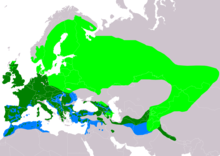Mistletoe
| Mistletoe | ||||||||||||
|---|---|---|---|---|---|---|---|---|---|---|---|---|

Mistle Thrush ( Turdus viscivorus ) |
||||||||||||
| Systematics | ||||||||||||
|
||||||||||||
| Scientific name | ||||||||||||
| Turdus viscivorus | ||||||||||||
| Linnaeus , 1758 |
The mistletoe ( Turdus viscivorus ) is a songbird from the thrush family (Turdidae). In Central Europe , the mistletoe is the largest native thrush, which is significantly larger than, for example, the blackbird .
description
The mistletoe reaches a body length of about 26 to 29 centimeters. The body weight can be up to 140 grams. In appearance, the Mistle Thrush similar song thrush , but only a maximum of 22 centimeters long. The upper side is gray-brown, and the underside is colored white with dark brown spots. The lower wing is colored white. Males and females have the same coloration.
Your call sounds something like "trr" or "zrr", a hard "tzerrrr" is also possible. Her singing consists of short, repetitive, melancholy fluting, long-lasting vocal stanzas, the sound of which lies between the blackbird and the song thrush. They are performed at almost the same pitch. The stanzas of the mistletoe are shorter and more monotonous than those of the blackbird, there are no pressed sound sequences. Mistle thrushes often also sing at lunchtime.
In flight, the mistletoe puts on its wings after each flapping phase, which creates the strong wave-like flight.
habitat
The distribution area of the mistletoe stretches across Europe (with the exception of western Scandinavia) and north-west Africa, the high mountains of the Near East and western Siberia to Lake Baikal. It is a short-range migrant in Central Europe that leaves its breeding area in November and returns in February. In milder regions it is a partial puller . Migratory birds overwinter in the Mediterranean and Western Europe.
The mistletoe lives in sparse forests , parks and smaller trees in Central Europe . In the south of its range it is mainly found in the mountains, but increasingly in localities in Central and Western Europe. Most mistletoe thrushes in the autumn towards southwest Europe and overwintered there.
nutrition
The mistletoe feeds on berries , fruits , mollusks , insects and their larvae . The majority of their food, however, is earthworms and, in winter, when there is snow or when the ground is frozen, the fruits of the white berry mistletoe , which is where the bird got its name. By eating the berries and soon afterwards excreting the seed kernels of this semi-parasite covered in sticky slime , this thrush, together with a few other bird species ("mistletoe-spreading birds"), contributes to its spread. It looks for food mainly on the ground, in meadows and pastures.
Reproduction
The mistle thrush breeds in light, tall forests, in park-like landscapes with trees, avenues and hedges, as well as in parks, cemeteries and gardens. The nest is usually built high in the trees in a fork of a branch. It is a relatively large, extensive bowl made of grass, stems, roots, moss, old leaves and moist soil by the female. The nesting trough is padded with fine grass.
The breeding season in Central Europe begins very early in March and ends in August. The female lays four to six eggs , which are incubated for about two weeks until the young birds hatch. The young birds fledge after 12 to 15 days and are then fed for a few more days. With a new onset of winter, early broods can lead to clutch losses.
Young birds are sexually mature after a year.
Cultural history
The ancient Romans scoffed at the ornithochory of the mistletoe: "Turdus ipse sibi cacat malum" (the thrush poops itself to spoil itself) because the bird contributes to the spread of the oak mistletoe ( Loranthus europaeus ). Bird glue is obtained from this plant , which in turn is used by bird trappers to hunt the mistletoe.
literature
- Einhard Bezzel: birds. BLV Verlagsgesellschaft, Munich 1996, ISBN 3-405-14736-0 .
- Collin Harrison, Peter Castell: Fledglings, Eggs and Nests of Birds in Europe, North Africa and the Middle East. Aula Verlag, Wiebelsheim 2004, ISBN 3-89104-685-5 .
Web links
- Turdus viscivorus in the endangered Red List species the IUCN 2008. Posted by: BirdLife International, 2008. Accessed January 31 of 2009.
- Videos, photos and sound recordings of Turdus viscivorus in the Internet Bird Collection
- Entry at the Swiss Ornithological Institute
- Age and gender characteristics (PDF; 4.3 MB) by Javier Blasco-Zumeta and Gerd-Michael Heinze (English)
- Mistletoe's feathers
Individual evidence
- ↑ Bezzel, p. 413.
- ↑ Detlef Singer: What is flying there? Franckh-Kosmos, Stuttgart, 2011, ISBN 978-3-440-12532-8 .
- ↑ Bezzel, p. 413.
- ^ Harrison, p. 238.
- ^ Manfred A. Fischer , Wolfgang Adler, Karl Oswald: Excursion flora for Austria, Liechtenstein and South Tyrol. 2nd, improved and enlarged edition. State of Upper Austria, Biology Center of the Upper Austrian State Museums, Linz 2005, ISBN 3-85474-140-5 .




